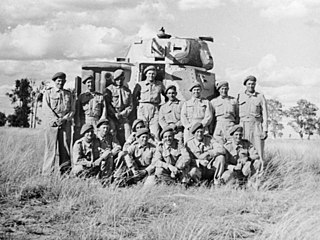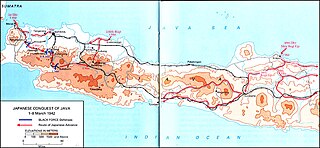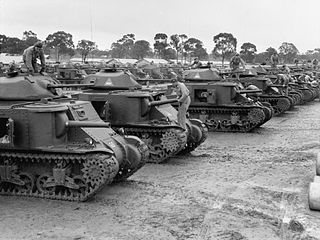
Operation Compass was the first large Allied military operation of the Western Desert Campaign (1940–1943) during the Second World War. British and other Commonwealth and Allied forces attacked Italian forces in western Egypt and Cyrenaica, the eastern province of Libya, from December 1940 to February 1941. The Western Desert Force with about 36,000 men, advanced from Mersa Matruh in Egypt on a five-day raid against the Italian positions of the 10th Army, which had about 150,000 men in fortified posts around Sidi Barrani in Egypt and in Cyrenaica.

The 1st Commonwealth Division was the name given, after July 1951, to Commonwealth land forces in the Korean War. The division was a multinational unit that was part of British Commonwealth Forces Korea, and whilst British and Canadian Army units formed the bulk of the division, Australian infantry, New Zealand artillery and an Indian medical unit were also a part of the division. As with the US "KATUSA" programme, numerous South Korean troops were seconded to the Commonwealth division to make up numbers under a programme known as "KATCOM".

The M3 Stuart, officially Light Tank, M3, was an American light tank of World War II. An improved version entered service as M5. It was supplied to British and other Commonwealth forces under lend-lease prior to the entry of the U.S. into the war. Thereafter, it was used by U.S. and Allied forces until the end of the war.

The M3 Lee, officially Medium Tank, M3, was an American medium tank used during World War II. In Britain, the tank was called by two names based on the turret configuration and crew size. Tanks employing US pattern turrets were called the "Lee", named after Confederate general Robert E. Lee. Variants using British pattern turrets were known as "Grant", named after Union general Ulysses S. Grant.

The Polish II Corps, 1943–1947, was a major tactical and operational unit of the Polish Armed Forces in the West during World War II. It was commanded by Lieutenant General Władysław Anders and fought with distinction in the Italian Campaign, in particular at the Battle of Monte Cassino. By the end of 1945, the corps had grown to well over 100,000 soldiers.

The Ariete Armoured Division was an armoured division of the Italian Army during World War II. It was formed in 1939 as the second armoured division in the Italian Army after the 131 Armoured Division Centauro. The division fought in the North African Campaign until being destroyed during the Second Battle of El Alamein. After World War II the division was reformed as part of the Italian Army.

The 2nd/14th Light Horse Regiment is a regiment of the Australian Army and forms part of the Royal Australian Armoured Corps. The regiment is an Australian Light Horse unit, and has been widely romanticised and popularised in literature and poetry throughout the 20th Century. The unit sentimentally traces its lineage to 1860 and is the oldest Australian Regular Army unit through antecedent units the 2nd Moreton Light Horse (QMI) and the 14th West Moreton Light Horse (QMI). The regiment is assigned to 7th Brigade based in Brisbane and is equipped with the M1A1 Abrams tank and the ASLAV reconnaissance vehicle.

The 3rd Armoured Division was an armoured unit of the Australian Army during World War II. Originally raised in 1921 as the 1st Cavalry Division, the formation had been converted into a motor division in early 1942, before adopting the armoured designation in November 1942. A Militia formation, the division undertook garrison duties in New South Wales and then Queensland and did not see combat before being disbanded in late 1943 and early 1944.

Armoured units made a relatively small, but important, contribution to Australia’s war effort during World War II. While Australia formed three armoured divisions and two independent armoured brigades during the war, Australian armoured units only saw action as independent regiments and companies supporting larger infantry formations. Early actions were fought in the Middle East by the divisional carrier regiments that supported the 6th, 7th and 9th Divisions, fighting in Libya, Egypt and Syria in 1941–42, before the Australian divisions returned to Australia in 1942–43. During the early fighting in the Pacific, there was a limited role for armoured formations, although one armoured regiment – the 2/6th – took part in the fighting around Buna–Gona in late 1942. Later in the war, though, during the Huon Peninsula, Bougainville and Borneo campaigns of 1943–45, several armoured units were used by Australian forces in the infantry support role.

The 2nd Tatsinskaya Guards Tank Corps was a Red Army tank corps that saw service during World War II on the Eastern Front. After the war it continued to serve with Soviet occupation forces in Central Europe. It was originally the 24th Tank Corps. The unit had approximately the same size and combat power as a Wehrmacht Panzer Division, and less than a British Armoured Division had during World War II.

The Type 89 medium tank I-Go was a medium tank used by the Imperial Japanese Army from 1932 to 1942 in combat operations of the Second Sino-Japanese War, at Khalkhin Gol against the Soviet Union, and in the Second World War. The Type 89B model was the world's first mass-produced diesel engine tank. The tank was armed with a short-barrel 57 mm cannon for knocking out pillboxes and masonry fortifications, and proved effective in campaigns in Manchuria and China, as the Chinese National Revolutionary Army had only three tank battalions to oppose them, which consisted primarily of Vickers export models, German Panzer Is, and Italian CV33 tankettes. The Type 89 was a 1920s design medium tank, built to support the infantry, and thus lacked the armor or armament of 1940s generation Allied armor; it was regarded as obsolete by the time of the 1939 battles of Khalkhin Gol, against the Soviet Union. The code designation "I-Go" comes from the katakana letter [イ] for “first” and the kanji [号] for "number". The designation is also transliterated Chi-Ro and sometimes "Yi-Go".

The Battle of Java was a battle of the Pacific theatre of World War II. It occurred on the island of Java from 28 February – 12 March 1942. It involved forces from the Empire of Japan, which invaded on 28 February 1942, and Allied personnel. Allied commanders signed a formal surrender at Japanese headquarters at Bandung on 12 March.
The Second Battle of El Alamein order of battle is a listing of the significant formations that were involved in the Second Battle of El Alamein during the Western Desert Campaign of the Second World War, 23 October – 4 November 1942.

The Maletti Group(Italian: Raggruppamento Maletti) was an ad hoc mechanised unit formed by the Italian Royal Army in Italian North Africa, during the initial stages of the Western Desert Campaign of the Second World War. The Italian army had three armoured divisions in Europe but all were needed for the occupation of Albania and the forthcoming invasion of Greece, which began on 28 October 1940. The Raggruppamento Maletti was formed in June 1940, as part of the 10th Army and contained all of the M11/39 medium tanks in Libya.

The Babini Group was an ad hoc armoured unit. The group was formed by the Italian Royal Army in Italian North Africa (Libya) at the start of the Western Desert Campaign of the Second World War. The group was formed in Libya, to assemble an armoured division from the tanks already in the colony and from units sent from Italy. The new division was incomplete when the British began Operation Compass in December but the Babini Group fought in defence of the area between Mechili and Derna in late January.
The Japanese Imperial Army landed the 25th Army under the command of General Tomoyuki Yamashita on the east coasts of Malaya and Thailand on the night of 7 December 1941.
The 1st Light Tank Company was an Australian Army armoured unit formed in 1937 equipped with the Vickers Medium Mark II medium tank.

This article deals with the history and development of tanks of the Polish army from their first use after World War I, into the interwar period, during World War II, the Cold War and modern era.

The Australian Army has used tanks from after the First World War, through the interwar period, the Second World War, the Cold War and to the present day. Throughout this period the Army has primarily been a light infantry force, with its tanks mainly being used in the direct support role. The Australian Army's tanks have seen combat during the Second World War and the Vietnam War, where they proved successful despite some of the designs employed being considered obsolete. The first Australian tanks were a small number of British medium and light tanks which were operated mainly for training purposes during the 1920s and 1930s.

















